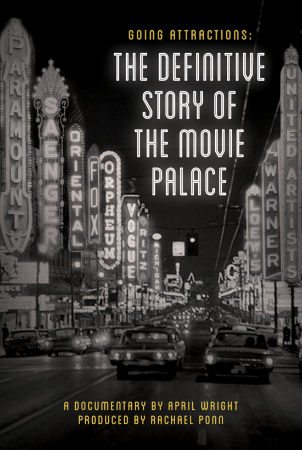
Going Attractions: The Definitive Story of the Movie Palace 2019
Distributed by Passion River Films, 154 Mt. Bethel Rd., Warren, NJ 07059; 732-321-0711
Produced by Rachel Ponn
Directed by April Wright
Streaming, 83 mins
Middle School - General Adult
Cinema History; Hollywood; Movie Palaces; Movie Theaters
Date Entered: 08/04/2020
Reviewed by Christopher Lewis, American University Library, American UniversityEurope has its cathedrals, castles, and chateaus, but in the United States, in the early twentieth century, it was the movies that were inspiring awe, and there was no setting better than the movie palaces. Yet it’s hard to imagine the world that willed these extravagant colossi into existence - not for the size so much as for the audacious designs and details. This documentary covers all that, from the birth of cinema to the heyday of the movie palace in the 1920s into the 1940s to their dereliction in the 1960s and 70s and their eventual revival. This story is thorough and fascinating and is just as much a history of the Hollywood studios, fan tastes, and urban development as it is of the architecture.
The story begins with the invention of the motion picture camera and the soon to follow development of penny arcades and Nickelodeons. Many of the now best-known theater chains, such as Loews, and studios, such as Fox, Warner Brothers, and Paramount, got established early from the profits yielded from the public’s new obsession with the movies. What began as modest store-front operations quickly evolved into more and more sophisticated oversized movie palaces. At their peak in 1927, theaters featured such things as powder rooms, smoking lounges, and uniformed ushers, and provided the average moviegoer with a transforming experience.
Though the introduction of the talkies in 1927 infused new life into the business, movie going hit its peak in 1930 with 70% of the population going to the movies on a weekly basis. What followed was a calamitous series of events that all but killed the traditional theater business. In succession the Great Depression, World War II, and the Consent Decree of 1946 that broke apart theater/studio ownerships, devastated the high-overhead business. When TV became popular just a couple years later it got even worse. Suburban living flourished in the postwar era as did the taste for modern style, so the big downtown palaces became quaint relics of a bygone era. By 1960 less than 10% of the population was going to a theater on a weekly basis.
By the 1960s and 70s much of the programming in the palaces had given way to repertory programming, grindhouse films, martial arts, blaxploitation, and pornography. The advent of the suburban multiplex and the drive-in theater were yet another dagger in the heart of the downtown theater.
Despite the architectural significance of the movie palaces, they were businesses on valued real estate foremost, so many were demolished to make way for office buildings and parking lots. Some became churches or drugstores or office buildings with movie theater facades. Despite the many losses, citizens groups in revitalized neighborhoods started to recognize the importance of these magnificent structures to their surrounding communities, and many classic theatres have been spared and restored as multi use venues for events including concerts, musical theater, and other live performances.
The video was lovingly composed with dozens of archival photos and sweeping drone’s-eye views into the far reaches of several existing theaters. The story is narrated by several preservation advocates and media historians including Leonard Maltin. There is discussion of many of the classic theaters in New York, Chicago, and Los Angeles and a wonderful reference list of dozens of other theaters that are still standing around the world.
The significance of the rise and fall of the movie palaces (and their recent revival) as an emblem of changing tides in American history is fascinating though it’s a bit of a stretch to call this a “definitive story”. There are just too many grand dames to consider. Nevertheless, it is a rich and enjoyable introduction to the subject and is highly recommended for students of film history, American architecture, fan studies, 20th Century American history, and urban studies.